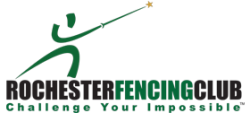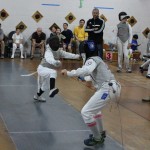
Intensity of Awareness: How to Improve Your Control of the Moment
What is intensity? What I mean by intensity isn’t so much related to how much speed and force your putting into the effort of execution, but more about the level of focus. As we all know when we’re practicing, our focus can vary in intensity from bout to bout and touch to touch. Part of enhancing your fencing skill is in improving the consistency with which you can maintain a high level of intense focus.
For many of my fencers, I try to explain this level of focus similarly to how I would explain meditation. Too often I observe fencers choosing an action they wish to perform, then rush through the execution or lack the ferocity needed to make the action work. Prior to the ‘fence’ command, they imagine the action as a whole piece, they know what steps need to be done and in what order. But once they get on guard, there is a lack of being in the moment. This is where the comparison of meditation is relevant. In a simple meditative breathing exercise, you sit comfortable, eyes closed to the outside distractions, and simply let your attention fall to the rhythm of your breath. Inhale, exhale. Inhale, exhale. You observe how the rhythm of breathing slows as you focus on the details, how your ribcage expands and releases with each inhale and exhale. Inevitably, other thoughts pop up. Ideally, you notice these thoughts, you let them fall away, and return your attention to your breathing. This is the most difficult part of meditation, not letting judgement fall on the incident of distraction, but rather just letting it be and returning to your breath.
Let’s step back a moment, how can this relate to skill execution? Meditation isn’t merely a focus on one’s breathe. It’s a focus on the present moment. You can meditate on pretty much anything, The taste of the food you eat, observing every detail from the sound of the first bite, the smell, different favors, and textures, to the execution of a full fencing action.
On strip, once you choose your plan of action, next comes the execution of that plan. Each action is comprised of several steps. The size and timing of each step is incredibly important to the success of the whole action. So how can you keep your focus on one step at a time? Work on first building your awareness of these individual steps. The most obvious way of improving this skill awareness is repetition of correct movement pattern. Start by execution the movements for the action slowly, making sure each step is correct, and emphasizing changes in tempo. Gradually add speed, taking care to make sure the footwork and hand movement maintains a high quality.
One thing you can do to initially develop this ability is to start by meditating on a simple fencing movement, such as an advance. Close you eyes while in en guard stance and begin to build awareness for the feel of your position. Begin your to advance at slow speed and observe how your weight shifts and how you roll your front foot heel to toe in your first step. Keep taking note of every elements of the movement you can find. Repeat this a few times, and then try again with variation in step size and notice the changes. Eventually, you can expand this awareness to how you move through more complex actions at more realistic speeds.
In addition to meditating on specific movements (which can be time consuming) you can also practice more complex actions through mental imagery outside of practice. In your mind, move through all the movements of your selected action, adding as many realistic details as possible, from the feel of your weapon in hand, to the sound of your foot as you accelerate into a lunge, to how it feels when your blade hits your opponent. Think about what errors typically occur for you with this action, and then go through mental imagery scenes where you progressively correct these errors. When you return to practice, you’ll have a better idea of the small details that require your intensive focus for the execution of this action.
To sum up, once you have chosen your plan, it comes down to the execution of the Individual steps within your plan. Each step needs to be executed to the right time and feeling, like a dance. Help build your ability to focus during the whole action by familiarizing yourself with the details of each step. This will help you recognize specifically where errors occur and how to isolate them. Break down complex actions with mental imagery and meditation so you can see which details are most critical for perfect execution.



